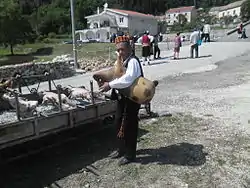Diple
Diple, (pluralia tantum; pronounced [dîple̞], with some other Croatian names also called as "misnjiče", "miješnice" and "mih". [1] is a traditional woodwind musical instrument in Bosnian and Herzegovinan,[2] Croatian, , Serbian[3][4][5] and Montenegrin music.
 | |
| Classification | |
|---|---|
| Related instruments | |
| |
The flute
The diple, or dvojnice, may be found as a fipple flute or as a reedpipe, but in either case is distinctive in that it incorporates two bores within one body, and thus creates two notes simultaneously. Generally, the left hand fingers a group of holes on the left side of the body, and the right on its side.
Droneless bagpipes
All bagpipe diple have a double chanter with two separate single reeds, they originate in Montenegro, Bosnia and Herzegovina and Dalmatia and they differ among themselves.[6] The bag of the bagpipes is called a meh, which consists of a tanned goat skin, the blowpipe is a dulac or gajdenica, through which the air is blown, which is in fact a double chanter used to play the melody and harmony simultaneously. The chanter incorporates two single reeds, one in each bore. The mijeh or diple is played from Istria all the way to Montenegro, in Lika, Dalmatian Hinterland and Bosnia and Herzegovina.[7][8]
Unlike the majority of European bagpipes, the meh has no drone (trubanj, prdalo, prdaljka), instead playing both a melody and harmony part on the chanter. Though their general form is similar, the meh in different parts of Bosnia varies in chanter tunings, ornamentation, and other small factors. The meh is an untempered instrument, and its specific intonation varies by region.
References
- Anthony Baines, 1979, Bagpipes, https://books.google.hr/books?id=a6MIAQAAMAAJ&q=Bagpipes+Anthony+Baines&dq=Bagpipes+Anthony+Baines&hl=hr&sa=X&ved=0ahUKEwi2u8_d1sDpAhVpoosKHdcvDpIQ6AEIJjAA #page=71
- Talam, Jasmina (2014-07-18). Folk Musical Instruments in Bosnia and Herzegovina. Cambridge Scholars Publishing. ISBN 978-1-4438-6427-5.
- Marković, Zagorka (1987). Narodni muzički instrumenti (in Serbian). Etnografski muzej. p. 75.
- "[Projekat Rastko] Sanja Radinovic: Darko Macura, srpski svirac". www.rastko.rs. Retrieved 2020-05-19.
- "Sviraj svirče". Nedeljnik Vreme. Retrieved 2020-05-19.
- Zagorka Marković, 1987, Narodni muzički instrumenti,https://books.google.com.bz/books?id=7i44AAAAMAAJ&printsec=frontcover#v=onepage&q&f=false #page=75
- Marijana Dlačić, Hrvoje Badurina, Tajna melodija ovčje kože, 2012, http://muzejovcarstva.org/wp-content/uploads/2017/07/MIH.pdf#page=17-18
- Anthony Baines, 1979, Bagpipes, https://books.google.hr/books?id=a6MIAQAAMAAJ&q=Bagpipes+Anthony+Baines&dq=Bagpipes+Anthony+Baines&hl=hr&sa=X&ved=0ahUKEwi2u8_d1sDpAhVpoosKHdcvDpIQ6AEIJjAA {The diple group of bell-less pipes, ranging along the Adriatic littoral from Istria to Montenegro and inland over Bosnia ad Herzegovina} #page=71-72